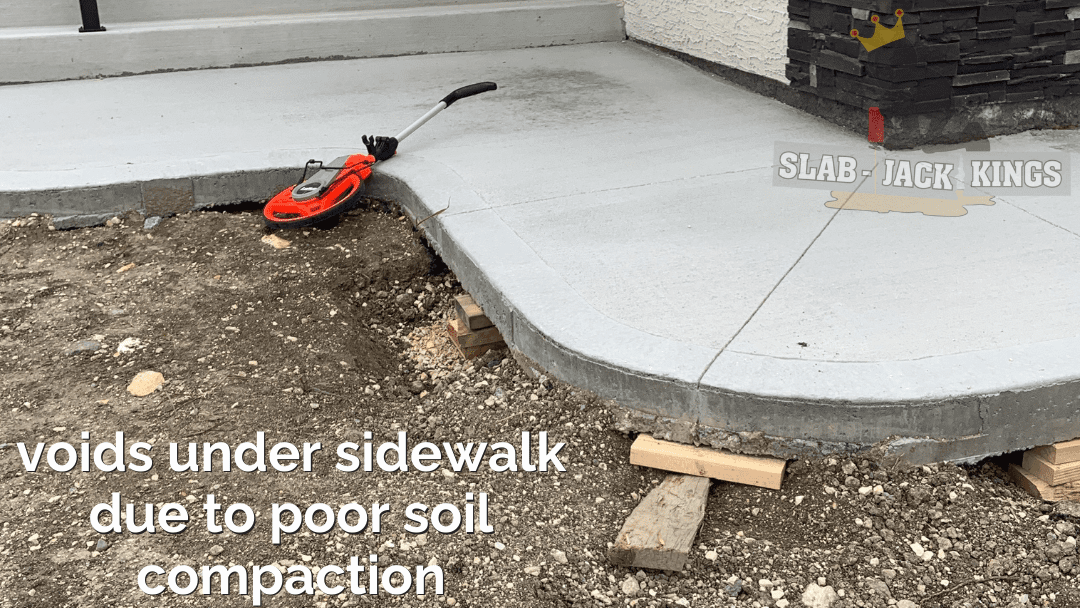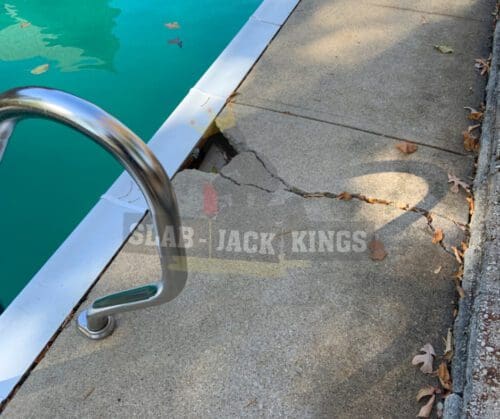Can All Concrete Be Restored? When is a slab too damaged to raise vs replace it?
What CAN’T Be Restored With Foam Jacking or Mudjacking
1. Precast or hollow cast steps and staircases:

Unfortunately we aren’t able to lift staircases like this. If you cannot see a slab beneath it then that means it would be tied into the house wall or it might also be fastened with a helical pile at the base.
If the step or staircase were sitting on top of a poured concrete slab, such as a patio, landing, driveway, etc. it could be possible. However, concrete raising materials for concrete lifting are made specially to lift poured concrete slabs and simply attempting to lift staircases like these with concrete lifting material can cost almost as much as replacement would be due to material cost and ends in breakage of the step or staircase itself, or your house foundation.

We recommend removing your hollow cast or precast step and replacing it with another staircase. If you’re finding you’ve had these settlement issues only over the past few years, installing a wooden staircase, as opposed to a concrete staircase would definitely release such a heavy burden on this unstable soil area. This would also be another cost-effective alternative solution for you. We usually recommend these over concrete staircases in the majority of the situations like yours.
2. Broken or overburden concrete with little-to-no rebar reinforcement:

Unfortunately when your concrete is too broken up, has too many larger gaps that are too close together, your concrete was not poured thick enough, too narrow or with not enough-no rebar, we cannot lift it.

The reason being is because concrete raising materials cannot defy gravity. They want to move in the path of least resistance, which means that these gaps and broken sections will not only allow the product to seep upwards towards the surface of your concrete, but they will also likely make it worse.

Concrete itself is not strong enough to withhold the pressure of a lifting product on its own when it is not properly reinforced with steel rebar.
3. Patio Stones/Landscaping Bricks, Asphalt, Etc:
You will need to contact a landscaping company in order to do this as this involves mechanical raising and levelling. Slab-Jack Kings uses polyurethane raising, levelling, void filling and stabilizing foam systems that are designed specifically for application and use beneath poured, slab-on-grade concrete slabs. A mudjacking or tindlestone mixture will not work on these either. If you are unsure on whether or not you have a poured, slab-on-grade concrete slab, please visit our gallery to view some photos and you will know right away once you see one of our photos.
4. Structural Pours/Slabs Utilizing Helical Piles:
If your concrete was poured on a pile (also known as a screw pile, screw anchor, or a helical anchor), this means that you have a ground anchoring system attached to a slab. This makes it a structural pour.
Footings and grade beams may have been poured with screw piles, but poured concrete slabs would only utilize screw piles if they were meant to be structural pours. If you are able to ask your home/building contractor whether or not it is a structural pour, we advise you do so for your own future reference in case you notice settlement.
This is most common with concrete staircases, & garage and basement floor grade beams and footings. If you have a structural pour that needs to be raised, you will need to contact a foundation specialist to inspect and mechanically raise or replace your structural slab.
If you are only worried about a loss of aggregates and you do not need any lifting done, we recommend void filling with our stabilizing foam systems to lock in your aggregates and keep out any water or critter infiltration. This must be done from above (injecting the product through the top of the slab with injection holes) if there is no complete access from the sides. If there is enough access from the sides, we also recommend that you fill the area with as much 1/4 down limestone as possible prior to requesting a void filling estimate. What we do in this situation once this has been done is void fill the area in order to fill any gaps and airspaces to lock in the aggregates in order to halt any water or critter infiltration into the affected area(s).
Can All Concrete Be Restored?
Ultimately, the answer to the question: “Can All Concrete Be Restored?” is no. However, if none of these apply to you… Contact Slab-Jack Kings for a free foam jacking estimate today!
Free Concrete Lifting Estimates within Manitoba & Northwestern Ontario!
We are a small, Canadian, family-based business that provides professional consultations, estimates and applications towards concrete slab lifting, levelling, void filling, stabilization and concrete under-slab insulation using polyurethane foam.
Our lifting professionals are equipped with vast knowledge and experience with concrete and this has made it possible to provide a personalized solution to any and all concrete problems.
Stop the threat of tripping or slipping on an uneven or out-of-level, poured concrete slab.
Contact Slab-Jack Kings today for an uplifting experience!
Need an estimate for a residential polyurethane concrete lifting project? Fill out our Request an Estimate form and one of our family members would be more than happy to help get you started.
Like what you see!? Like us on Facebook and follow us on Instagram!


















